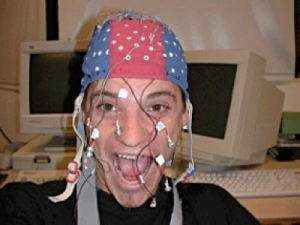
Ph.D., Complex Systems & Brain Sciences, October, 2006
Current Position: Postdoctoral Fellow, UC San Francisco
Dissertation:
NEURAL CORRELATES OF AUDITORY PERCEPTION, ATTENTION AND EXPECTATION
This dissertation examined the neural correlates of auditory perception, attention and expectation in three experiments. Experiment 1 analyzed neural correlates of auditory perception and expectation in an electroencephalography (EEG) experiment using a temporally perturbed metronome to establish an expectation for auditory events, then violate and reestablish that expectation. High frequency evoked (phase-locked) gamma band activity (GBA) was observed to follow the onset of tones whereas induced (non-phase-locked) GBA reached maximum power simultaneously with the occurrence of tone onset. Moreover, the latency of induced GBA was perturbed after an expectancy violation and relaxed back into synchrony as the expectation was reestablished.
Experiment 2 was a methodological study to determine the usefulness of sparse sampling, a functional magnetic resonance imaging (fMRI) scanning technique designed to minimize MR noise interference. Subjects passively listened to isochronous tone sequences at three rates while two different scanning techniques were employed (sparse and continuous). Sparse sampling was observed to yield fMRI data comparable to continuous scanning, however, continuous scanner noise was observed to perturb known EEG evoked response potentials. Moreover, spectral analysis identified evoked activity as attenuated with the presence of continuous fMRI noise.
Experiment 3 was conducted to study auditory expectancy and attention. First, subjects were tested behaviorally to determine their ability to tap the beat of ten highly syncopated patterns. Subjects were asked to return for one EEG and one fMRI session. In these sessions, they were instructed to attend to a syncopated pattern, mentally rehearse the pattern, and then reproduce the pattern. During the control condition, subjects heard the auditory patterns, however, they were instructed to study a list of words, remember the words during the retention interval, and then report all words remembered. Brain activity was localized to frontal and auditory regions when attending to the patterns and occipital-auditory areas when attending to the words. Evoked activity was shown to reflect the subject’s anticipation of the beat and was attenuated when ignoring the auditory stimulus.
Taken together, these results suggest that GBA indexes auditory perception, attention and expectation. The current results suggest that attention and task engagement may elicit stronger neural phase locking.